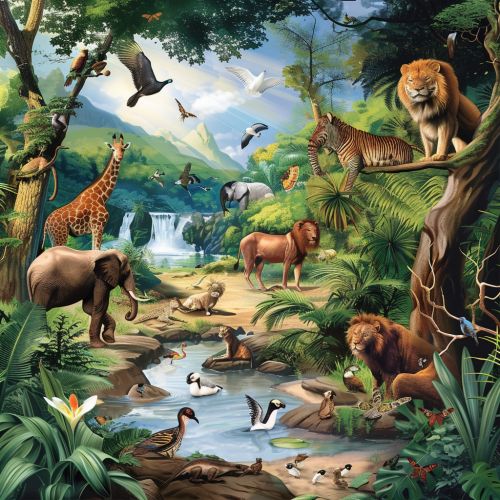Conservation Status: Difference between revisions
(Created page with "== Overview == Conservation status is a critical indicator used to assess the risk of extinction that a particular species faces. It is a measure that helps scientists, conservationists, policymakers, and the public understand the urgency and type of actions needed to protect and preserve biodiversity. The conservation status of a species is determined by evaluating various factors including population size, rate of decline, geographic range, and the degree of populatio...") |
No edit summary |
||
| Line 21: | Line 21: | ||
* **Not Evaluated (NE)**: Has not yet been evaluated against the criteria. | * **Not Evaluated (NE)**: Has not yet been evaluated against the criteria. | ||
[[Image:Detail-79537.jpg|thumb|center|A diverse group of animals in their natural habitats, illustrating the importance of conservation efforts.|class=only_on_mobile]] | |||
[[Image:Detail-79538.jpg|thumb|center|A diverse group of animals in their natural habitats, illustrating the importance of conservation efforts.|class=only_on_desktop]] | |||
=== CITES === | === CITES === | ||
Latest revision as of 20:15, 18 May 2024
Overview
Conservation status is a critical indicator used to assess the risk of extinction that a particular species faces. It is a measure that helps scientists, conservationists, policymakers, and the public understand the urgency and type of actions needed to protect and preserve biodiversity. The conservation status of a species is determined by evaluating various factors including population size, rate of decline, geographic range, and the degree of population and distribution fragmentation.
Classification Systems
Several organizations and systems are used to classify and evaluate the conservation status of species. The most widely recognized and utilized system is the IUCN Red List of Threatened Species, which categorizes species into nine groups ranging from "Least Concern" to "Extinct." Other notable systems include the Convention on International Trade in Endangered Species of Wild Fauna and Flora (CITES) and the Endangered Species Act (ESA) in the United States.
IUCN Red List
The IUCN Red List is a comprehensive inventory that evaluates the global conservation status of plant and animal species. The categories are as follows:
- **Extinct (EX)**: No known individuals remaining.
- **Extinct in the Wild (EW)**: Known only to survive in cultivation, in captivity, or as a naturalized population outside its historic range.
- **Critically Endangered (CR)**: Extremely high risk of extinction in the wild.
- **Endangered (EN)**: High risk of extinction in the wild.
- **Vulnerable (VU)**: High risk of endangerment in the wild.
- **Near Threatened (NT)**: Likely to become endangered in the near future.
- **Least Concern (LC)**: Lowest risk; does not qualify for a more at-risk category.
- **Data Deficient (DD)**: Not enough data to make an assessment of its risk of extinction.
- **Not Evaluated (NE)**: Has not yet been evaluated against the criteria.


CITES
CITES is an international agreement between governments aimed at ensuring that international trade in specimens of wild animals and plants does not threaten their survival. It classifies species into three appendices:
- **Appendix I**: Species threatened with extinction. Trade in specimens of these species is permitted only in exceptional circumstances.
- **Appendix II**: Species not necessarily threatened with extinction, but in which trade must be controlled to avoid utilization incompatible with their survival.
- **Appendix III**: Species that are protected in at least one country, which has asked other CITES Parties for assistance in controlling the trade.
Endangered Species Act (ESA)
The ESA is a key legislation for both domestic and international conservation in the United States. It provides a framework to conserve and protect endangered and threatened species and their habitats. The ESA classifies species as either "Endangered" or "Threatened" and mandates federal agencies to ensure that their actions do not jeopardize the continued existence of these species or destroy their critical habitat.
Factors Influencing Conservation Status
The determination of a species' conservation status involves a detailed assessment of various factors:
Population Size and Trends
Population size is a fundamental parameter in assessing conservation status. Small populations are more vulnerable to extinction due to genetic drift, inbreeding depression, and demographic fluctuations. Trends in population size, whether increasing, stable, or declining, also provide critical insights into the species' viability.
Geographic Range
The extent of a species' geographic range is another crucial factor. Species with a limited distribution are more susceptible to extinction due to habitat loss, environmental changes, and stochastic events. The degree of fragmentation within the range also impacts the species' ability to survive and reproduce.
Habitat and Ecology
The specific habitat requirements and ecological roles of a species are considered when evaluating its conservation status. Species that depend on specialized habitats or have narrow ecological niches are more vulnerable to changes in their environment. The availability and quality of habitat are critical for the survival of these species.
Threats
Identifying and understanding the threats facing a species is essential for conservation planning. Common threats include habitat destruction, climate change, overexploitation, pollution, invasive species, and disease. The severity, scope, and immediacy of these threats are assessed to determine their impact on the species.
Conservation Actions
Effective conservation requires a combination of strategies tailored to the specific needs of the species and the threats they face. These actions can be broadly categorized into in-situ and ex-situ conservation.
In-Situ Conservation
In-situ conservation involves protecting species in their natural habitats. This approach includes the establishment and management of protected areas, habitat restoration, legal protection, and community-based conservation initiatives. In-situ conservation aims to maintain the ecological processes and interactions that are essential for the long-term survival of species.
Ex-Situ Conservation
Ex-situ conservation involves the preservation of species outside their natural habitats. This includes captive breeding programs, seed banks, botanical gardens, and zoos. Ex-situ conservation serves as a complementary strategy to in-situ efforts, providing a safety net for critically endangered species and facilitating research, education, and reintroduction programs.
Monitoring and Assessment
Continuous monitoring and assessment are vital components of conservation efforts. Regular surveys, population censuses, and ecological studies provide data on the status and trends of species. Advanced technologies such as remote sensing, geographic information systems (GIS), and molecular genetics are increasingly used to enhance monitoring capabilities.
International and National Legislation
Legislation at both international and national levels plays a crucial role in conservation. International agreements such as the Convention on Biological Diversity (CBD), Ramsar Convention on Wetlands, and the Bonn Convention on Migratory Species provide frameworks for global cooperation. National laws, such as the ESA in the United States, the Wildlife Protection Act in India, and the Environment Protection and Biodiversity Conservation Act in Australia, establish legal protections and conservation measures within countries.
Challenges and Future Directions
Despite significant progress, conservation efforts face numerous challenges. These include limited funding, political and social conflicts, climate change, and the complexity of ecological systems. Future directions in conservation emphasize the integration of traditional knowledge, community participation, and adaptive management. Advances in technology, such as environmental DNA (eDNA) analysis and artificial intelligence, offer new tools for monitoring and protecting biodiversity.
